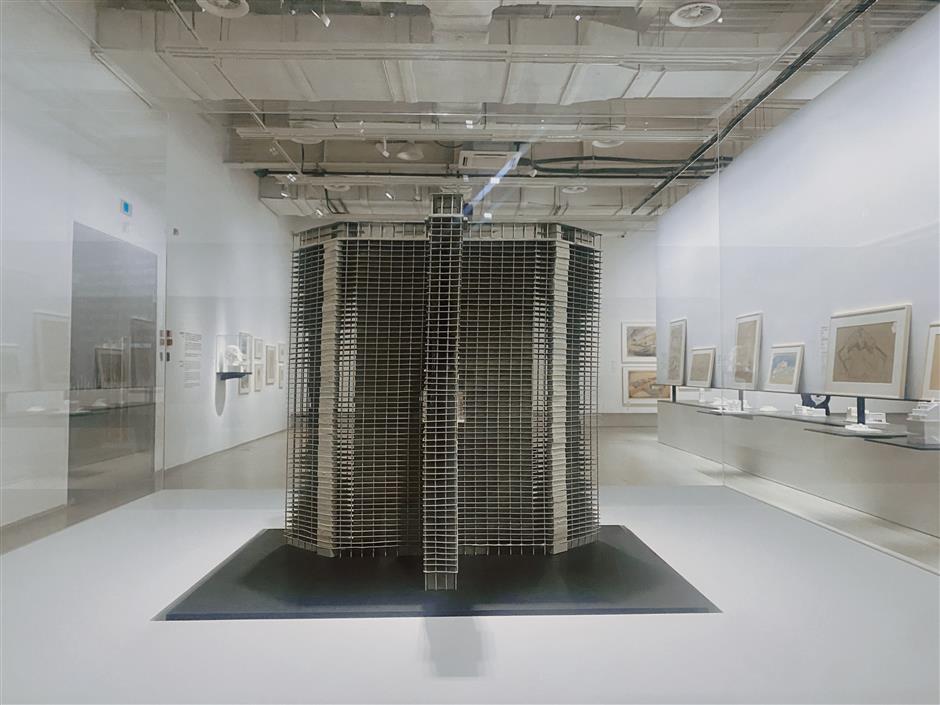Showcasing modernity of Paris from 1914 through 1945
The exhibition "Paris Moderne 1914-1945: Architecture, Design, Film and Fashion," ongoing at the Power Station of Art in Shanghai, takes visitors on a journey to the Paris of 1914 through 1945, showcasing the modernity and creation of that era.
It features more than 300 objects, including manuscripts, models, furniture, films, posters, photographs, magazines, clothes, cosmetics and jewellery.
The exhibition that runs through October 12 was curated by late renowned architectural historian Jean-Louis Cohen and architect Pascal Mory, with Catherine Ormen on the fashion section.
"I would say that the period between 1914 and 1945 was an age of invention of form and industrial production," said Cohen, who worked in Paris for nearly 50 years. "It was really the image of the city of a machine age but with a poetic dimension."
Cohen passed away at the age of 74 in France on August 7 this year.
In the ground-floor exhibition hall, a large projection screen displays postcards depicting the illuminated Eiffel Tower in 1925. That year, the tower was illuminated using 250,000 light bulbs, thanks to the talent of lighting engineer Fernando Jacopozzi.
The Citroën car company had rented the Eiffel Tower, and the Citroën brand name was displayed in lights across the tower, making the landmark an advertising space.

Postcards depicting the illuminated Eiffel Tower in 1925 are displayed on a screen.
The highlight of the exhibition is architecture. It features original blueprints from different architects, including Le Corbusier, Auguste Perret and Adolf Loos, showcasing the architecture and urban planning of that period in Paris.
In particular, Le Corbusier takes center stage within this exhibition. Cohen, who previously curated several exhibitions related to Le Corbusier, is a preeminent authority on the architect.
As an architect, urban planner, painter and publicist, le Corbusier was a central figure in interwar Paris and shaped the perceptions of modern architecture.
"A house is a machine for living in," he stated. Le Corbusier emphasized functionalism and efficiency in architecture, rejecting decorative art. This was influenced by the developments in technology in the Machine Age.
He praised products of that era, such as airplanes and cars, and advocated for a machine logic that prioritized functionality and efficiency, according to the Power Station of Art.
Furthermore, Le Corbusier developed the principle of "five points of architecture" – pilotis (columns), free-form interior designs, free-form facade designs, horizontal windows, and rooftop gardens. One of his most well-known projects, Villa Savoye, is the physical embodiment of his five points.

A contemporary model of Villa Savoye is displayed at the exhibition.
His drawings also convey his ideas on the transformation of the center of Paris. The "Cartesian" skyscrapers he imagined in 1935 form the prehistory of the vertical cities we see today in European, North American and Asian cities.

An original model for a "Cartesian" skyscraper from 1935
A 6-meter-by-6-meter demountable prefabricated house is showcased in the exhibition, originally designed by French architect Jean Prouvé. Although this kind of house is not unusual to us today, it was innovative in that era.
Wooden pieces and welded steel sheets were shipped from abroad, and the house was constructed on site in the exhibition hall.

A reconstruction of a demountable house designed by Jean Prouvé
The exhibition is a story not only of architecture, but of many aspects of modern culture in the French capital.
Using the same production techniques as those in the 1920s, the exhibition reconstructed "The Interior Equipment of a Dwelling" exhibited at the 1929 Paris Salon d' Automne.
Designed by Charlotte Perriand, one of the few women to gain recognition at the time, along with architects Le Corbusier and Pierre Jeanneret, the installation represented the main rooms of a dwelling: the kitchen, bedroom, bathroom and a living room.

A reconstruction by Cassina of the Salon d' Automne
The exhibition also features wax heads, haute couture, cosmetics, minaudière and jewellery from that period in Paris. Additionally, there were Chinese-style minaudière featuring Chinese characters.
"The changing fashion of Parisian women's clothing was not only a reflection of modernity but also a manifestation of shifting social trends," said Ormen at the opening of the exhibition.

Haute couture garments from the era are on display.

Chinese characters are embellished on minaudière from the era in Paris.
Framing the modern city as an example, the exhibition will also present diverse historical references for studies on modernism in Shanghai.
"Similar to Paris, Shanghai operates like a massive machine," said Cohen in an interview with thepaper.cn. "Both cities, being megacities, face various social issues. Apart from drawing insights from history as references for modern urban planning, they also need their own adjustment."
Exhibition info:
Date: Through October 20 (closed on Mondays), 11am-7pm
Admission: 80 yuan
Venue: Power Station of Art
Address: 678 Miaojiang Road, Huangpu District
黄浦区苗江路678号















